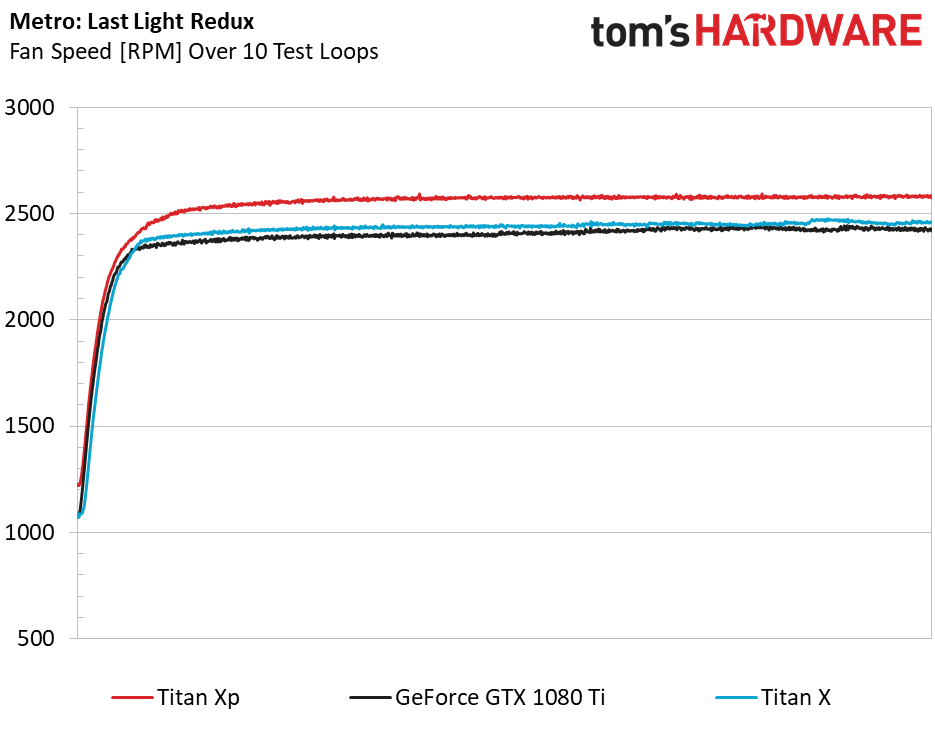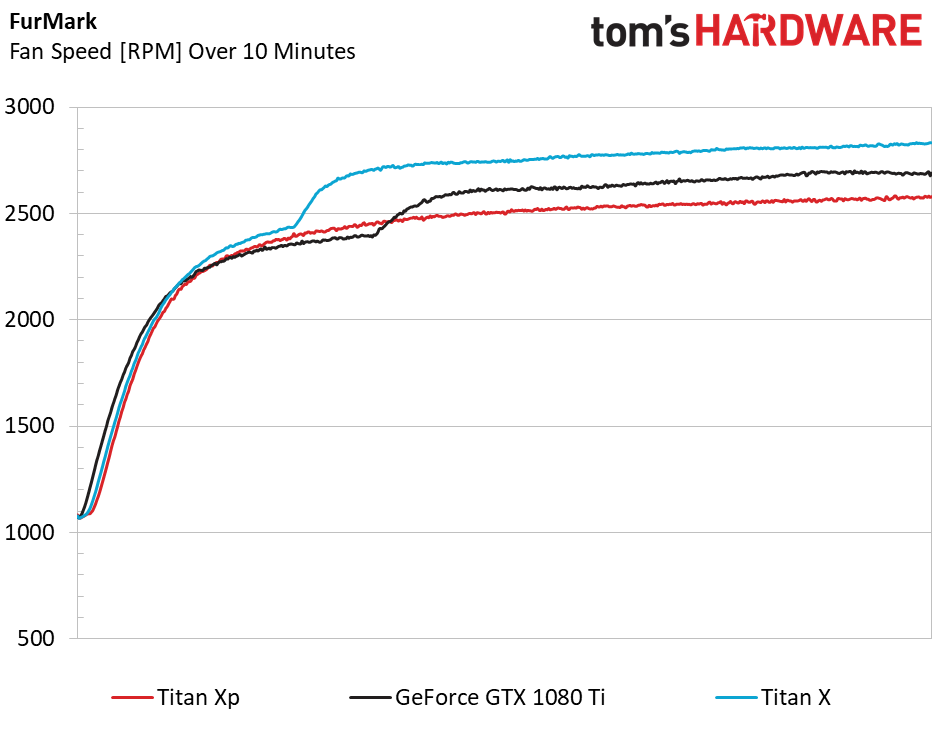Nvidia Titan Xp 12GB Review
Why you can trust Tom's Hardware
Fan Speed
Gaming Loop
This happens because Titan Xp’s fan speed curve is steeper than the other two cards.
How is it possible for a more complex GPU to operate at a higher frequency, temperature and power limit being equal? Well, the Titan Xp’s fan averages more than 2500 RPM, while 1080 Ti and Titan X both average less than 2400 RPM. All three cards end the test thermally-limited, but greater cooling performance lets Titan Xp bounce around at an advanced clock rate within that 84°C threshold.
Stress
Nvidia doesn’t need to spin Titan Xp’s fan as fast in this scenario. Because its 3840-core GPU hits its power limit at a much lower clock rate, the cooler doesn’t struggle to keep up. Instead, it’s the Titan X that strains above 2800 RPM by the time our 10-minute test ends.
Remember that 1080 Ti and Titan Xp both benefit from a freer-flowing thermal solution (at the cost of a DVI output). The design tweak appears to pay off here, though, under extreme duress.
Notice also that GeForce GTX 1080 Ti and Titan X demonstrate a sudden bump in fan speed, corresponding to the point where they overshoot their temperature targets. Such a rapid speed-up is audibly distinct. Meanwhile, Titan Xp’s clock rate starts lower as it immediately runs into a power limit, resulting in a slower temperature increase that never gets away from the fan.
MORE: Best Graphics Cards
MORE: Desktop GPU Performance Hierarchy Table
Get Tom's Hardware's best news and in-depth reviews, straight to your inbox.
MORE: All Graphics Content
-
With this card Nvidia completed the current generation of their graphic chips. They are onto new one...the best company out there.Reply
-
TMTOWTSAC GPU makers are really going to have to hope QHD, 4k, machine learning, and VR really take off within the next 4 years.Reply -
dstarr3 Meet the new boss, same as the old boss. If all you need a GPU for is gaming, go one step down, save hundreds of dollars, at the cost of only a handful of FPS.Reply -
AgentLozen ReplyFreak777power said:With this card Nvidia completed the current generation of their graphic chips. They are onto new one...the best company out there.
I was thinking something similar while I was reading this. The Titan Xp represents the very furthest that the Pascal architecture can go. This current crop of cards from the 1050 to the Titan Xp will carry us to Volta's launch.
(wait, isn't there a card even smaller than the 1050? /shrug)
Edit: Why isn't this quote working?
Edit2: Figured it out =) -
AndrewJacksonZA "The Titan Xp represents the very furthest that the Pascal architecture can go. This current crop of cards from the 1050 to the Titan Xp will carry us to Volta's launch."Reply
I have to agree. Even though I don't like them as a company due to some of their business practices, I have to give them credit for being a stylish company that really pushes it and completes their line-ups - I like things to be *complete*... :-) -
AndrewJacksonZA Thanks for putting in the effort for this review, Chris! Appreciate your contributions around here. :-)Reply -
bentonsl_2010 Reply(wait, isn't there a card even smaller than the 1050? /shrug)
I believe you are talking about the 1030. This isn't really a gaming card however, it's more geared for e-sports streaming and HTPC type builds. -
hannibal Could you test this card with a water block?Reply
This seems to be monster that would really benefit from that... -
barryv88 $500 for a measly increase over the Ti. Add another $200 premium that Gsync screens cost over Freesync ones, and you've happily payed +- $700 Nvidia tax for the "New coolest kid on the block" title.Reply
Yeaaaa. Thanks, but no thanks! -
AgentLozen Replybarryv88 said:$500 for a measly increase over the Ti. Add another $200 premium that Gsync screens cost over Freesync ones, and you've happily payed +- $700 Nvidia tax for the "New coolest kid on the block" title.
Yeaaaa. Thanks, but no thanks!
You know if someone handed you a Titan Xp you would stick it right in your box without a second though.
bentonsl2010 said:I believe you are talking about the 1030. This isn't really a gaming card however, it's more geared for e-sports streaming and HTPC type builds.
Yes. That's the one.
I mentioned it to illustrate that nVidia has a very wide portfolio with something for everyone. Pascal has been a terrific generation for nVidia.


